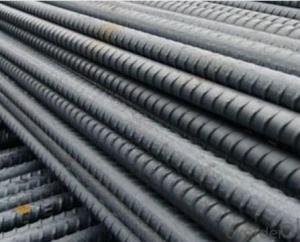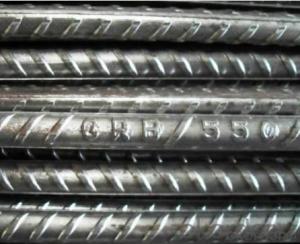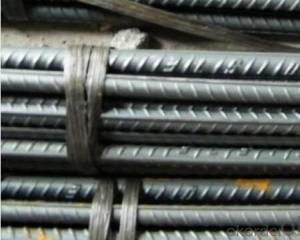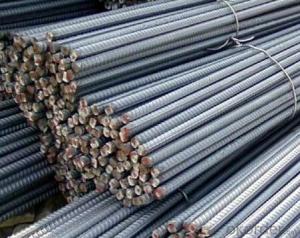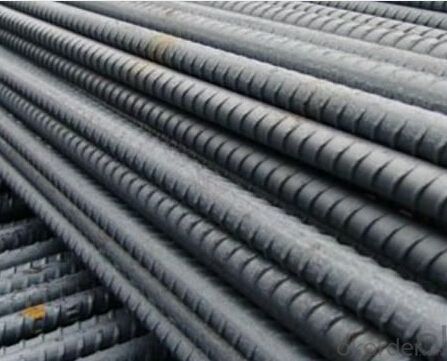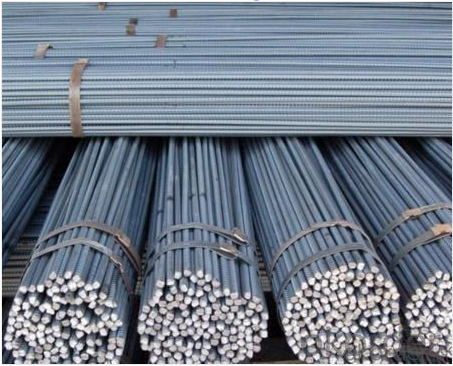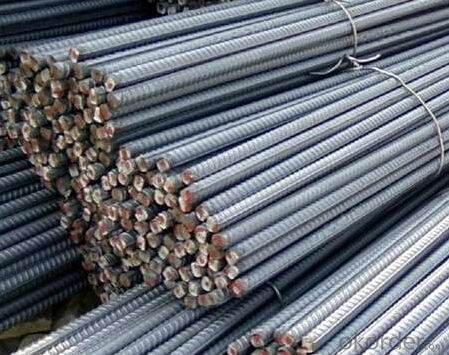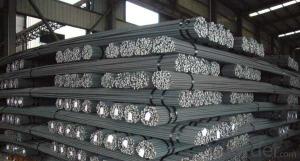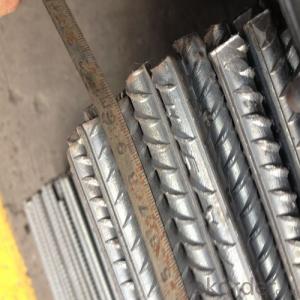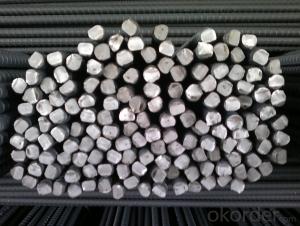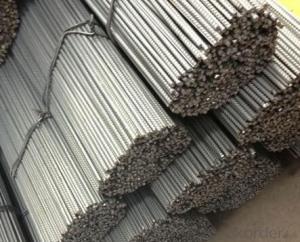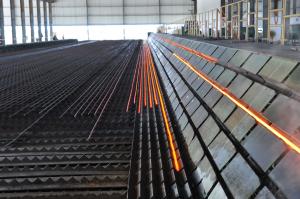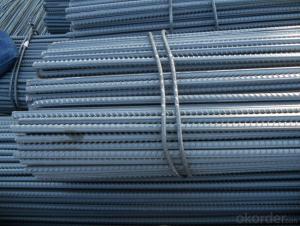Deformed Steel Bar with Standard ASTM A615
- Loading Port:
- Tianjin
- Payment Terms:
- TT OR LC
- Min Order Qty:
- 100 m.t.
- Supply Capability:
- 5000 m.t./month
OKorder Service Pledge
OKorder Financial Service
You Might Also Like
Product Description:
OKorder is offering Deformed Steel Bar with Standard ASTM A615 at great prices with worldwide shipping. Our supplier is a world-class manufacturer of steel, with our products utilized the world over. OKorder annually supplies products to European, North American and Asian markets. We provide quotations within 24 hours of receiving an inquiry and guarantee competitive prices.
Product Applications:
Deformed Steel Bar with Standard ASTM A615 are ideal for structural applications and are widely used in the construction of buildings and bridges, and the manufacturing, petrochemical, and transportation industries.
Product Advantages:
OKorder's Deformed Steel Bar with Standard ASTM A615 are durable, strong, and resist corrosion.
Main Product Features:
· Premium quality
· Prompt delivery & seaworthy packing (30 days after receiving deposit)
· Corrosion resistance
· Can be recycled and reused
· Mill test certification
· Professional Service
· Competitive pricing
Specifications of Deformed Steel Bar with Standard ASTM A615:
Standard | GB UK USA | HRB335 HRB400 HRB500 G460B, B500A, B500B,B500C GR40, GR60 | |
Diameter | 6mm,8mm,10mm,12mm,14mm,16mm,18mm,20mm, 22mm,25mm,28mm,32mm,36mm,40mm,50mm | ||
Length | 6M, 9M,12M or as required | ||
Packing | Export standard packing: wrapped by wire rod in bundles | ||
Each bundle weight | 2-3MT, or as required | ||
Trade terms | FOB, CFR, CIF | ||
Payment terms | TT payment in advance or Irrevocable LC at sight. | ||
Delivery Detail | within 45 days after received advanced payment or LC. | ||
Brand name | DRAGON | ||
Theoretical weight and section area of each diameter as below for your information:
Diameter(mm) | Section area (mm²) | Mass(kg/m) | Weight of 12m (kg) | Pcs/ton |
6 | 28.27 | 0.222 | 2.664 | 375.38 |
8 | 50.27 | 0.395 | 4.74 | 210.97 |
10 | 78.54 | 0.617 | 7.404 | 135.06 |
12 | 113.1 | 0.888 | 10.656 | 93.84 |
14 | 153.9 | 1.21 | 14.52 | 68.87 |
16 | 201.1 | 1.58 | 18.96 | 52.74 |
18 | 254.5 | 2.00 | 24 | 41.67 |
20 | 314.2 | 2.47 | 29.64 | 33.74 |
22 | 380.1 | 2.98 | 35.76 | 27.96 |
25 | 490.9 | 3.85 | 46.2 | 21.65 |
28 | 615.8 | 4.83 | 57.96 | 17.25 |
32 | 804.2 | 6.31 | 75.72 | 13.21 |
36 | 1018 | 7.99 | 98.88 | 10.43 |
40 | 1257 | 9.87 | 118.44 | 8.44 |
50 | 1964 | 15.42 | 185.04 | 5.40 |
Chemical Composition: (Please kindly find our chemistry of our material based on JIS as below for your information)
JISG3112 SD390 | Chemical Composition | ||||
C | Mn | Si | S | P | |
0.22 | 1.38 | 0.4 | 0.014 | 0.022 | |
Physical capability | |||||
Yield Strength(N/cm²) | Tensile Strength(N/cm²) | Elongation (%) | |||
620 | ≥400 | 21 | |||
The production process of Deformed Steel Bar with Standard ASTM A615
1-Waling beam furnace
2-Roughing rolling group
3-Intermediate rolling train
4-Finishing rolling group
5-Water-cooling device
6-Walking beam cooler
7-Finishing equipment(including the cold scale shear,short feet collection system,
automatic counting device,bundling machine, collect bench)
Usage and Applications of Deformed Steel Bar with Standard ASTM A615:
Deformed bar is widely used in buildings, bridges, roads and other engineering construction. Big to highways, railways, bridges, culverts, tunnels, public facilities such as flood control, dam, small to housing construction, beam, column, wall and the foundation of the plate, deformed bar is an integral structure material. With the development of world economy and the vigorous development of infrastructure construction, real estate, the demand for deformed bar will be larger and larger..
Packaging & Delivery of Deformed Steel Bar with Standard ASTM A615:
Packaging Detail: products are packed in bundle and then shipped by container or bulk vessel, deformed bar is usually naked strapping delivery, when storing, please pay attention to moisture proof. The performance of rust will produce adverse effect.
Price: Keep lower operating costs so as to offer competitive price for our clients
FAQ:
Q1: Why buy Materials & Equipment from OKorder.com?
A1: All products offered byOKorder.com are carefully selected from China's most reliable manufacturing enterprises. Through its ISO certifications, OKorder.com adheres to the highest standards and a commitment to supply chain safety and customer satisfaction.
Q2: How do we guarantee the quality of our products?
A2: We have established an advanced quality management system which conducts strict quality tests at every step, from raw materials to the final product. At the same time, we provide extensive follow-up service assurances as required.
Q3: How soon can we receive the product after purchase?
A3: Within three days of placing an order, we will begin production. The specific shipping date is dependent upon international and government factors, but is typically 7 to 10 workdays.

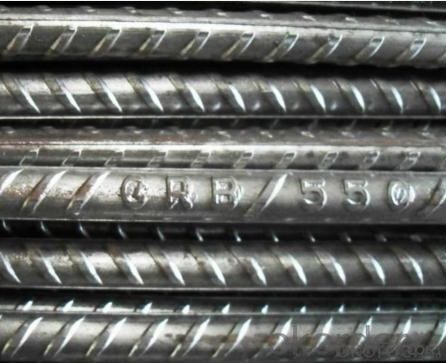
- Q: How do steel rebars affect the overall cost of maintenance?
- The overall cost of maintenance can be significantly affected by steel rebars in various ways. Firstly, the structural integrity of buildings and infrastructure heavily relies on the quality and durability of steel rebars. When properly installed and of high quality, steel rebars can strengthen and prolong the lifespan of concrete structures, reducing the frequency of repairs or replacements. Consequently, this reduces maintenance costs over time. Furthermore, steel rebars offer reinforcement to concrete, enhancing its resistance to external forces such as seismic activities, heavy loads, and environmental factors like corrosion. By increasing structural resilience, steel rebars can minimize the occurrence of damage, thus reducing the subsequent expenses required for maintenance and restoration. In addition, it is crucial to maintain steel rebars properly to prevent corrosion. Regular inspections, cleaning, and application of protective coatings are necessary preventive measures. Failure to do so can result in rust and corrosion, ultimately compromising the structural integrity of the entire concrete structure. Addressing corrosion-related issues through repairs or replacements can be both time-consuming and expensive, significantly impacting the maintenance budget. Lastly, the choice of steel rebars during construction or renovation can also impact maintenance costs. While opting for higher-grade rebars with superior corrosion resistance may initially increase upfront costs, it can substantially reduce long-term maintenance expenses. Investing in high-quality steel rebars minimizes the need for frequent repairs and replacements, leading to cost savings and improved structural reliability. In conclusion, steel rebars directly influence the overall cost of maintenance. By providing reinforcement and improving structural integrity, high-quality rebars reduce the necessity for repairs, prevent damage, and enhance the durability of concrete structures. However, neglecting proper maintenance of rebars can lead to expensive corrosion issues. Thus, careful consideration of the quality, installation, and ongoing maintenance of steel rebars is essential to minimize long-term maintenance costs.
- Q: Can steel rebars be used in pre-stressed concrete construction?
- Yes, steel rebars can be used in pre-stressed concrete construction. In pre-stressed concrete, steel rebars are commonly used to provide additional strength and reinforcement to the concrete structure. These rebars are placed strategically and pre-tensioned or post-tensioned to withstand the applied loads and enhance the overall performance and durability of the construction.
- Q: What are the different types of steel rebars used in tunnel constructions?
- Tunnel constructions rely on the use of different steel rebars to strengthen and fortify the tunnels. These rebars play a vital role in providing stability and reinforcement to the tunnel structures. Below are several types of steel rebars commonly utilized in tunnel constructions: 1. Mild Steel Rebars: Also known as black or carbon steel rebars, mild steel rebars are the most frequently employed in tunnel constructions. They are both cost-effective and possess sufficient strength to meet the structural demands of tunnels. 2. High-Strength Steel Rebars: High-strength steel rebars, sometimes referred to as tension steel, offer enhanced tensile strength, making them ideal for tunnels that require high load-bearing capabilities. These rebars are typically fabricated from alloys such as ASTM A615 Grade 80 or ASTM A706 Grade 80. 3. Stainless Steel Rebars: Stainless steel rebars are resistant to corrosion and provide excellent durability in harsh tunnel environments. They are commonly used in tunnel constructions where corrosion protection is vital, such as in marine or coastal areas. 4. Epoxy-Coated Rebars: Epoxy-coated rebars are regular mild steel rebars that have been coated with epoxy to safeguard against corrosion. They are often employed in tunnel constructions that are exposed to moisture, chemicals, or other corrosive elements. 5. Galvanized Rebars: Galvanized rebars are coated with a layer of zinc to shield them from corrosion. They are commonly used in tunnel constructions that are exposed to moisture or in regions with high humidity levels. 6. Fiberglass Rebars: Fiberglass rebars, also known as GFRP (Glass Fiber Reinforced Polymer) rebars, are lightweight and resistant to corrosion. They are used in tunnel constructions where reducing weight is crucial or in areas with high electromagnetic interference. 7. Carbon Fiber Rebars: Carbon fiber rebars, also called CFRP (Carbon Fiber Reinforced Polymer) rebars, possess high tensile strength and are resistant to corrosion. They are often utilized in tunnel constructions that require high tensile strength and resistance to chemical or environmental degradation. Choosing the appropriate type of steel rebar for tunnel constructions depends on various factors such as load-bearing requirements, exposure to corrosion, environmental conditions, and project budget. It is advisable to consult with structural engineers or construction experts to ensure the optimal selection of steel rebars for tunnel projects.
- Q: Can steel rebars be used in earthquake-prone areas?
- Yes, steel rebars can be used in earthquake-prone areas. Steel rebars are commonly used in construction in seismic zones as they provide reinforcement and enhance the structural integrity of buildings and infrastructure. Their high tensile strength and ability to absorb and distribute the forces generated during an earthquake make them an effective solution for earthquake-resistant construction. Additionally, steel rebars can be designed and installed in a way that allows them to withstand the specific seismic forces expected in a particular area, further ensuring the safety and stability of structures in earthquake-prone regions.
- Q: What is the process of inspecting steel rebars on-site?
- The quality and adherence to specifications of steel rebars on-site are ensured through a series of steps in the inspection process. Firstly, a visual inspection is conducted to identify any visible defects or damage, such as rust, cracks, bends, or improper dimensions. Immediate attention is given to any issues found. Next, accurate measurements are taken using tools like calipers or measuring tapes. The length, diameter, and shape of each rebar are compared against the project specifications to ensure they meet the required dimensions. For certain projects, chemical analysis of the steel rebars may be necessary to confirm their composition and strength. Samples are taken from different batches and sent to a lab for testing, with the results determining compliance with standards. Non-Destructive Testing (NDT) techniques are utilized to evaluate the internal integrity of the rebars without causing damage. Ultrasonic testing, magnetic particle inspection, and radiography are employed to detect hidden defects like cracks, voids, or inclusions. If welding is involved, the inspector checks the welds for proper penetration, alignment, and quality. This guarantees the strength and integrity of the joint. Throughout the inspection process, detailed records are maintained. These records include information about the inspections conducted, measurements taken, test results, and identified defects. They serve as evidence of compliance and can be referred to in case of disputes or future reference. Once the inspection is complete, a detailed report is prepared summarizing the findings. This report is shared with the project management team, engineers, and other relevant stakeholders. It highlights any non-compliance, defects, or areas that require attention. In conclusion, the on-site inspection of steel rebars is a comprehensive and systematic approach that ensures their quality, integrity, and compliance with project specifications and industry standards.
- Q: Are there any specific guidelines for storing and handling steel rebars?
- Yes, there are specific guidelines for storing and handling steel rebars. Here are some important points to consider: 1. Storage: Steel rebars should be stored in a clean, dry, and well-ventilated area to prevent corrosion. They should be stacked on timber or other suitable materials to keep them off the ground and avoid contact with moisture. 2. Handling: Steel rebars should be handled with care to prevent any damage or bending. It is recommended to use appropriate equipment such as cranes, forklifts, or strong hooks to lift and move rebars. Avoid dragging or dropping them, as it can result in deformations and weaken their structural integrity. 3. Bundling: Rebars should be properly bundled and tied together using steel wires or straps to prevent them from rolling or shifting during storage or transportation. This ensures their stability and reduces the risk of accidents. 4. Separation: Different sizes and types of rebars should be separated and clearly labeled to avoid confusion during construction. This helps in easily identifying and using the required rebar as per the structural plans. 5. Protection: Rebars should be protected from exposure to moisture, rain, snow, and other weather elements. If rebars are stored outdoors, waterproof covers or tarps should be used to shield them and prevent rust formation. 6. Inspection: Regular inspections should be conducted to identify any signs of corrosion, damage, or bending. Any defective or compromised rebars should be removed and replaced to ensure the structural integrity of the construction project. 7. Transportation: During transportation, rebars should be securely fastened and loaded onto suitable vehicles to prevent movement or falling off. Adequate padding and tie-downs should be used to protect rebars from damage and ensure safe transportation. It is crucial to follow these guidelines to maintain the quality, durability, and safety of steel rebars throughout their storage and handling process.
- Q: Are there any limitations or restrictions on using steel rebars in construction?
- Yes, there are certain limitations and restrictions on using steel rebars in construction. Here are some of them: 1. Corrosion: Steel rebars are prone to corrosion when exposed to moisture and certain chemical environments. This can weaken the rebars over time and compromise the structural integrity of the construction. To mitigate this limitation, protective coatings or stainless steel rebars can be used. 2. Fire Resistance: Steel rebars can lose their strength and become malleable when exposed to high temperatures during a fire. This can lead to structural failure. Fireproofing measures such as fire-resistant coatings or using concrete encasement can help enhance the fire resistance of steel rebars. 3. Weight: Steel rebars can be quite heavy, especially for large-scale construction projects. This can pose challenges during transportation, handling, and installation. It may require additional labor or equipment to handle the weight, which can increase project costs. 4. Thermal Expansion: Steel has a relatively high coefficient of thermal expansion, meaning it expands and contracts significantly with temperature changes. This can lead to thermal stresses and potential cracking in the concrete surrounding the rebars. Proper design techniques and the use of expansion joints can help accommodate thermal expansion and mitigate this limitation. 5. Electromagnetic Interference: Steel rebars can interfere with electromagnetic signals, such as those used in communication systems or sensitive electronic equipment. This limitation needs to be considered when constructing buildings with specific requirements, such as hospitals or laboratories. 6. Cost: The cost of steel rebars can fluctuate depending on market conditions, availability, and quality. This can impact the overall budget of construction projects, especially when large quantities of rebars are required. It is important to note that while steel rebars have limitations, they have been widely used in construction due to their strength, durability, and availability. Proper design, construction techniques, and maintenance can help overcome these limitations and ensure the safe and efficient use of steel rebars in buildings and infrastructure.
- Q: Can steel rebars be used in structures with limited construction permits?
- Steel rebars can typically be used in structures with limited construction permits, as they are commonly used in construction due to their strength and durability. However, it is important to consult the specific regulations and limitations outlined in the construction permits. These permits may have restrictions on the types of materials that can be used, including the size and composition of rebars. It is advisable to consult with a structural engineer or the local building authority to ensure compliance with the construction permits and to determine if steel rebars are allowed in the particular structure.
- Q: Can steel rebars be used in underground structures?
- Yes, steel rebars can be used in underground structures. Steel rebars are commonly used in construction, including underground structures such as tunnels, basements, and foundations. The high strength and durability of steel rebars make them suitable for reinforcing concrete structures in underground environments, providing enhanced structural integrity and ensuring long-term stability and safety.
Send your message to us
Deformed Steel Bar with Standard ASTM A615
- Loading Port:
- Tianjin
- Payment Terms:
- TT OR LC
- Min Order Qty:
- 100 m.t.
- Supply Capability:
- 5000 m.t./month
OKorder Service Pledge
OKorder Financial Service
Similar products
Hot products
Hot Searches
Related keywords
